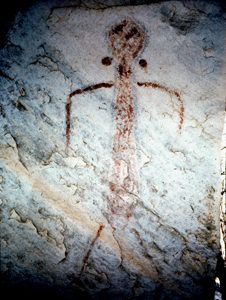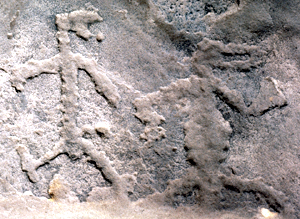|
The Human Body
By Deborah Sabo
Ways of depicting the human body in Arkansas rock art vary in style and execution. Some of this variation shows affinities with rock art in other parts of North America. For example, the figures at The Narrows site, with their rectangular bodies and down-turned arms, bear some resemblance to Plains rock art. Others are more similar to Eastern Woodlands styles.
Other sites in Arkansas have human figures drawn or scratched as simple stick figures. Usually, a similar bent-arm posture and out-turned foot is shown on these designs as well. Sometimes the arms are bent up rather than down. Human figures in rock art often have unusual features that capture our attention. For example, although the body is typically depicted in a simplified style, sometimes there are large hands with splayed fingers. Or there might be objects attached to the hands. Are the humans holding something? Or do they have “magical appendages”
Human figures also frequently have unusual heads in rock art. This often seems pretty clearly to represent a headdress or other ornament like the earspools shown above. In other cases, there is definitely a non-human head, as with these images of bird- or lizard-headed humans from a site in Van Buren County. Large round heads, or heads with horns attached are other variations.
All of this suggests that the human body when depicted in Arkansas rock art often represented a mythical person rather than an everyday portrait. But this was not always the case. The group of figures at The Narrows appears to show parents and children and may depict a small community group taking part in a ceremony of dancing, drumming and singing. A human figure riding a horse seems natural enough. And it is important to realize that in the belief system of Southeastern Indians, individuals often felt themselves led by a guide or mentor in the spirit world who might appear to them in visions as a certain animal. The person identifies himself strongly with his spirit mentor. Therefore, to depict the human body with some animal traits might not have seemed as unusual to ancient Indians as it does to us. Another way of depicting the human body in Arkansas rock art is by hand and foot prints. Archeologists do not know if these motifs are “shorthand” representations of persons, a sort of signature, or if they represent action and motion as part of a narrative, or are symbols laden with special meaning. The open hand, for instance, was an important symbol in Woodland and Mississippian period religious iconography. |


